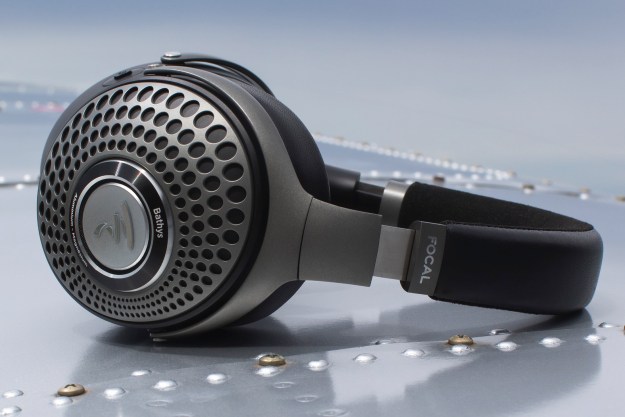
“The Aftershokz Aeropex are smaller, sleeker, and more convenient than ever.”
- Light, comfy frame
- Clear and open upper register
- Fully water and dust resistant
- Solid battery life
- Open-ear design keeps you safe
- Lacking in instrumental definition
- Weak bass response
- Minor fatigue over long listening periods
There’s no shortage of fantastical ways to get your wireless audio kicks in 2019, from tiny, totally wireless noise-canceling earbuds to headphone sunglasses that beam sound into your ears via hidden micro-speakers. But even several years on, bone-conduction headphones from Aftershokz, which bypass your ear canal via vibrating pads to buzz music through your skull, remain among the most intriguing ways to take your tunes along wherever you go.
The latest from Aftershokz, the Aeropex, are the company’s smallest, sleekest, and most advanced bone conductors yet. And with so many new contenders in the wire-free space, they need to be. After several years away, I was happy to discover the Aftershokz still hold a spot among the audio world’s most convenient wireless contraptions.
Tiny coil of sound
If I had any doubts about just how much time had passed since I last strapped a pair of Aftershokz on my noggin (and with my graying hair, there weren’t many), opening the Aeropex’s chic white box put them quickly to rest. Even after reviewing pair after pair of the world’s smallest wireless earbuds, the Aeropex’s micro-sized coil makes a real impression.
The company has shaved a full 30% off its previous pair and gone down several sizes from the BlueEZ I auditioned back in 2013, crafting its latest conduction pads into a nimble, rubberized halo that’s strikingly light (just 26 grams) and succinct.
Set just behind the right conduction pad is one of two bulbs along the slim circlet that houses both a basic control piece and the bulk of the inner gadgetry. Controls are handled by a versatile volume rocker that also serves as the power/pairing key. It took me some time (longer than I’d like to admit) to find the other piece of the puzzle — a multifunction key set subtly on the left conduction pad that handles play/pause/calling and song skip.
One quibble with the controls: A loud beeping tone accompanies every control you press, which tends to out-blast the audio. It’s kind of annoying, but not a huge problem.
They’ll stand up to just about any weather you’ll encounter.
Layered in rubbery material (referred to in the industry by a name I can’t utter here), the Aeropex offer an IP67 dust/water resistance rating that allows them to stand up to just about any weather you’ll encounter, and even be submerged for up to 30 minutes in 3 feet of water.
A British assistant dubbed Audrey (which totally doesn’t sound like Alexa) walks you through commands, including demanding you charge her when the 8-hour battery runs low. You can also call up your phone’s own assistant via a long press of the multifunction key. The battery life isn’t amazing for 2019, but for a device this small, it’s more than ample and won’t leave you hanging in any but the most relentless Iron Man workouts.
What’s the deal with bone conduction?
The basic point of bone conduction is to leave your ear canal free to experience the world around you while you jam out to your favorite tunes or podcasts. To do so, the pads are designed to literally buzz sound through a bone in your skull to reach your inner ears.
It’s an intriguing idea, and we’re not sure you’re not getting at least some of the sound through your ear canal — the pads get louder the closer they approach — but it does allow you to crank up the volume and still keep your ears open to ambient sound for better awareness than earbuds with microphones that do the same thing.

The first time I tried an Aftershokz product, the tingly buzz took some time getting used to, but the company has improved on this a fair bit. The Aeropex only tingle a smidgen when placed in front of your ears, and the sound appears to just pop inside your head.
I did notice they tend to create a bit of what can be described as outer-ear fatigue during extra-long listening sessions, though they aren’t really designed for that anyway. I also think part of that may be due to tighter clamping force in the halo’s design, which is likely to ease up a bit over time.
Aeropex in action
If high-fidelity in-ear headphones like Sennheiser’s Momentum paint a vibrant sonic canvas, bone-conduction headphones are more like a charcoal sketch of the soundscape — all the beats are there but instruments aren’t as colorfully fleshed out. The Aeropex definitely offer more meat on the bone then my previous bone-conduction experience (no pun intended), especially in the treble register where sound is clear, resonant, and relatively open.
Bone conductors have always struggled mightily with bass, though, and that’s still the case here. While the latest Aftershokz model has improved down low, you’re simply not going to get a ton of thump from those little pads.
Still, what these headphones do better than any traditional pair is allow you to splash sound into your workout while still remaining present and aware of everything around you. Their airy weight adds to the convenience, letting you strap them on and forget them while you jog, hike, or bike your way to a good sweat. You can even wash them off when you’re done.
Splash sound into your workout while still remaining present and aware.
I had plenty of fun moments playing around with them, particularly when taking our new pup, Syd, for a run. The Aeropex allowed me to listen to tunes or call up podcasts, and even slow down to take a phone call, all without missing anything Syd did or heard. As with the Bose Frames, I also had a great time chatting with my wife on walks, while piping in some tunes for a little extra ambience.
Even headphones that offer audio pass-through features via their onboard microphones can’t compete with open-ear headphones in this department, especially when it comes to biking, where the tiny microphones quickly surrender to the mighty blast of the wind in your ears.
In fact, only Bose’s Frames fare better, simply because they offer richer and more dynamic sound. But being sunglasses, they also have their own limitations, such as being rendered useless at the gym and less-than-ideal for darker days – that’s not to mention their measly 3.5-hour battery life.
Call quality
Calling works pretty well, though the quality is also a bit tinny, losing some vocal warmth. The microphone system also had more trouble filtering out wind noise when compared to some newer true wireless buds, including Apple’s latest AirPods.
Our Take
While still far from hi-fi wonders, the latest bone-conduction headphones from Aftershokz are smaller, sleeker, and more convenient than ever, making them ideal candidates for those who take their workouts with a healthy side of ambient sound.
Is there a better alternative?
If you’re looking for open-air listening, there are few products that do what bone-conduction headphones can, with the Aeropex’s biggest competition being the company’s other more affordable (and bulkier) headsets. Bose’s Frames are also another great option, as they offer better sound quality, but also have limitations in both use cases and battery life. (The Frames also have only very basic water resistance.)
If you want something more versatile than either product, we recommend looking into fully wireless earbuds like Jabra’s Elite Active 65t or the very popular and pricey Powerbeats Pro (though we had some connection issues with two different pairs).
How long will it last?
With impressive water- and dustproofing, plenty of battery life, and a nimble but flexible design, we expect the Aeropex to be a part of your workout routine for a good long while.
Should you buy it?
If you’re looking for small, tough, and convenient workout buds that will rock along with you in just about any environment, and keep you fully aware of said environment, the answer is definitely.
If you’re looking for something with higher sound quality that will roll with you to the office as easily as the gym, it’s worth checking out our lists of the best fully wireless earbuds or best running headphones.
Editors' Recommendations
- The best wireless headphones for 2023: which should you buy?
- The first wireless hi-res headphones with UWB will arrive in 2024
- The best headphones for running in 2023
- Audio-Technica’s $2,700 wooden wireless headphones do something no other headphones can do
- 13 things to consider when buying headphones for someone else







